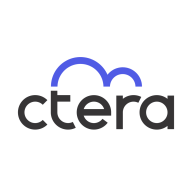

CTERA Enterprise File Services Platform and Acronis Disaster Recovery compete in the data management and protection category. CTERA may have the edge in file-sharing capabilities, while Acronis offers superior disaster recovery features.
Features: CTERA Enterprise File Services Platform provides global file sharing, automated backup, and seamless collaboration, making it ideal for organizations focused on enhancing teamwork. Acronis Disaster Recovery offers robust data recovery, quick recovery times, and data integrity, ensuring business continuity during disruptions.
Ease of Deployment and Customer Service: CTERA simplifies deployment with cloud integration, allowing easy access and collaboration. It benefits from simple file synchronization across devices. Acronis offers a flexible deployment model with strong disaster recovery protocols and prioritizes fast recovery during service interruptions.
Pricing and ROI: CTERA Enterprise File Services Platform has competitive pricing beneficial for long-term collaboration investments. Acronis Disaster Recovery involves higher initial setup costs, justified by its extensive feature set and enhanced safety measures, making the investment worthwhile for reliable disaster recovery solutions.
My customers are finding value in Acronis Disaster Recovery, as they are happy with the tool and continue to use the services after facing many situations where they found it useful and got good returns on their investment.
Acronis regularly introduces new features to meet customer needs, which can lead to efficiencies.
Adding SSD storage to Windows file servers is expensive, and we no longer need to back up those devices.
I am positive that CTERA has helped reduce the total cost of ownership by eliminating the need for manual storage management and reducing storage service processes.
A high-level technical team should be accessible swiftly to minimize customer downtime.
The technical support is reliable and efficient.
We face issues connecting with the account manager, which needs to be improved.
They swiftly address concerns and take ownership of the call, providing a very satisfactory support experience.
High-priority issues are handled promptly.
I would rate their support a ten out of ten.
The scalability of Acronis Disaster Recovery is good, and I would rate it an eight out of ten.
It is easy to scale; you can directly add licenses for scalability.
If we need to upgrade CPU and memory, we should be able to do that without a license upgrade.
CTERA is a very scalable product, allowing us to grow.
It offers good scalability options, including vertical and outward scalability.
We have not experienced any downtime, bugs, or glitches.
It has been pretty stable since then.
We had things deployed for years, and we were suddenly getting cloud sync issues that were crashing our sites.
It is very stable and reliable.
They could also enhance endpoint security by integrating EDR within the security framework.
For the backup to compete in the enterprise market, there must be improvements.
If a server is completely offline and destroyed, the system should offer an intelligent response, providing options to start recovery without requiring manual intervention from engineers.
AI and automation features could enhance the platform, such as AI-powered search, predictive storage analytics, and intelligent alerts for proactive monitoring.
The main problem is that if two people are working on the same file, for example, one in the U.S. and one in Israel, they can overwrite each other’s work without any notification.
It would help to have a global single-pane-of-glass view of all my CTERA devices.
The pricing for Acronis products has increased by 10% to 15% over the past few years, making it challenging for existing customers to accommodate the rising costs annually.
Acronis Disaster Recovery is fairly priced.
The price for Acronis Disaster Recovery is fair from the perspective of features, but for Indian customers and in light of the competition, it would be better if the price were a little lower to pitch services more effectively.
Unlike other solutions that require hardware purchases, CTERA offers software licensing with flexibility across multiple infrastructure providers.
CTERA’s pricing should be more proportional and accessible so that cost is not the factor preventing customers from purchasing.
CTERA's pricing seems to be on par with some of the other players, such as Nasuni and Azure.
The ability to automate the backup solution and recover entire mailboxes or even granular-level emails is very good for restoration and backup.
For data recovery, when we lose a server, we are able to restore it in place with the click of a button.
Backup is crucial as it allows data recovery.
As soon as something is written to the device, CTERA copies it to the cloud, where it's versioned with snapshots so we can recover it.
A vital advantage of this platform is its instantaneous recovery capability, allowing seamless access to a secondary gateway if the primary one fails.
It is a three-in-one solution for us. It is a file-sharing platform, an archiving solution, and also a backup solution.
| Product | Market Share (%) |
|---|---|
| CTERA Enterprise File Services Platform | 1.0% |
| Acronis Disaster Recovery | 0.4% |
| Other | 98.6% |


| Company Size | Count |
|---|---|
| Small Business | 13 |
| Midsize Enterprise | 1 |
| Large Enterprise | 3 |
| Company Size | Count |
|---|---|
| Small Business | 2 |
| Midsize Enterprise | 2 |
| Large Enterprise | 6 |
Acronis Disaster Recovery Service is a hybrid cloud, all-in-one, IT continuity solution that protects and restores your data and servers in the event of a natural or man-made disaster. Leveraging the power of the Acronis AnyData Engine, Acronis Disaster Recovery Service can reliably recover your servers or entire data centers without the need for you to invest in duplicate systems or additional staff.
Acronis Disaster Recovery Service can reliably recover your servers or entire data centers without the need for your organization to invest in duplicate systems or additional staff. Providing flexible recovery time objective (RTO) options, Acronis Disaster Recovery Service combines the high performance and shortest recovery time of a local appliance with the low cost, predictability, and accessibility of a virtual private cloud.
The CTERA Enterprise File Services Platform provides a cloud-native global file system over public and private object storage, revolutionizing the world of hybrid cloud data solutions. Enhanced by a rich data services ecosystem, CTERA enables enterprises to gain full control of their data for optimal edge performance, data insight, and governance. The platform focuses on security, providing features like data encryption, access controls, and ransomware protection. Centralized management tools enable efficient data control and monitoring. The platform is being used to replace legacy NAS and file servers, especially at remote locations, and simplify backup and disaster recovery of file data while providing the flexibility of multi-cloud deployments with infinite scalability. CTERA is at the core of hybrid cloud transformations of some of the world’s largest banks, healthcare organizations, global media groups, and government agencies, in deployments that scale to tens of petabytes.
We monitor all Disaster Recovery (DR) Software reviews to prevent fraudulent reviews and keep review quality high. We do not post reviews by company employees or direct competitors. We validate each review for authenticity via cross-reference with LinkedIn, and personal follow-up with the reviewer when necessary.